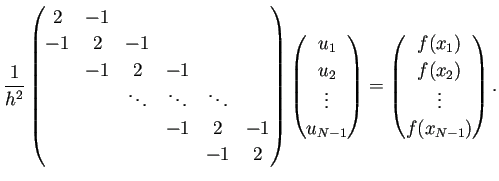Next: 2.2 Neumann境界値問題 Up: 2 1次元Poisson方程式 Previous: 2 1次元Poisson方程式
 (
(

| laplacian1d.m |
% laplacian1d.m % curl -O https://m-katsurada.sakura.ne.jp/program/fdm/laplacian1d.m % -(d/dx)^2 の差分近似 % [0,L] を N 等分した時の行列は h=L/N; a=laplacian1d(N-1)/(h*h); function a=laplacian1d(m) e=ones(m,1); a=spdiags([-e 2*e -e],-1:1,m,m); % 疎行列なので圧縮した形式 end |
>> a=laplacian1d(3));
>> full(a)
ans =
2 -1 0
-1 2 -1
0 -1 2
|
![]() を
を ![]() 等分する差分近似の場合は
等分する差分近似の場合は
>> L=1;
>> n=5;
>> h=L/n;
>> a=laplacian1d(n-1)/(h*h);
>> full(a)
ans =
50.0000 -25.0000 0 0
-25.0000 50.0000 -25.0000 0
0 -25.0000 50.0000 -25.0000
0 0 -25.0000 50.0000
|
![]() における
における
| poisson1d_test1.m |
L=1 n=10 h=L/n x=linspace(0,L,n+1); a=laplacian1d(n-1)/(h*h); f=ones(n-1,1); u=a\f; u=[0; u; 0]; plot(x,u) figure(gcf) |
![]() の場合は
の場合は
| poisson1d_test2.m |
L=1 n=10 h=L/n x=linspace(0,L,n+1); a=laplacian1d(n-1)/(h*h); f=sin(x(2:n))'; u=a\f; u=[0; u; 0]; plot(x,u) figure(gcf) |
![]() の場合は
の場合は
| poisson1d_test3.m |
L=1 n=10 h=L/n x=linspace(0,L,n+1); a=laplacian1d(n-1)/(h*h); f=x.*(1-x); f=f(2:n)'; u=a\f; u=[0; u; 0]; plot(x,u) figure(gcf) |
(2024/9 改訂版) 非同次Dirichlet境界値問題のプログラム。
| poisson1d_nh.m |
% poisson1d_nh.m
% 1次元領域におけるPoisson -△u=f (非同次Dirichlet境界条件) を差分法で解く
% 入手 curl -O https://m-katsurada.sakura.ne.jp/program/fdm/poisson1d_nh.m
% 解説 https://m-katsurada.sakura.ne.jp/labo/text/poisson1d.pdf
% (2024/9/4)。
function poisson1d_nh(N)
arguments
N=4 % デバッグ用
end
function K = poisson1d_mat(W,N)
h=W/N;
I=speye(N-1,N-1);
v=ones(N-2,1);
J=sparse(diag(v,1)+diag(v,-1));
K=2*I-J;
K=1/h^2*K;
end
% 想定している厳密解
function val = exact_solution(x)% =x^4
val = x .^ 4;
%val = (x - 1.0/2).^2;
end
% f=-△u=-d^2u/dx^2
function val = f(x)% = -u''(x) = -12x^2
val = - 12 * x.^2;
%val = 0 .* x - 2.0;
end
% 領域
a=0; b=1;
% 境界値
alpha = exact_solution(a);
beta = exact_solution(b);
fprintf('a=%f, b=%f, u(a)=%f, u(b)=%f\n', a, b, alpha, beta);
% 差分近似の行列
h=(b-a)/N;
fprintf('N=%d, h=%g\n', N, h);
A=poisson1d_mat(b-a,N);
if N <= 10
disp('A='); disp(full(A));
end
% 連立方程式の右辺
X=linspace(a,b,N+1);
F=f(X(2:N)');
F(1)=F(1)+alpha/h^2;
F(N-1)=F(N-1)+beta/h^2;
if N <= 10
disp('X='); disp(X);
disp('F=f(X)='); disp(F');
end
% 差分解を求める
u=zeros(N+1,1);
u(2:N)=A\F;
% 境界値
u(1)=alpha; u(N+1)=beta;
% グラフを描く
plot(X,u); title('差分解のグラフ'); drawnow; shg;
figure
plot(X,exact_solution(X')); title('厳密解のグラフ'); drawnow; shg;
exact=exact_solution(X');
error=norm(u-exact,inf);
fprintf('max norm of error=%e\n', error);
end
|
入手するにはターミナルで
curl -O https://m-katsurada.sakura.ne.jp/program/fdm/poisson1d_nh.m |
これを実行するには、例えば
cp -p poisson1d_nh.m ~/Documents/MATLAB |
>> poisson1d_nh(分割数はデフォールトの |
>> poisson1d_nh(10) |
上のサンプル・プログラムでは、
![]() と選び、
と選び、
![]() ,
,
![]() ,
,
![]() としてある。
としてある。
![]() を
を ![]() から倍々にしていくと以下のようになった。
から倍々にしていくと以下のようになった。
N=10, h=0.1 max norm of error=2.500000e-03 N=20, h=0.05 max norm of error=6.250000e-04 N=40, h=0.025 max norm of error=1.562500e-04 N=80, h=0.0125 max norm of error=3.906250e-05 N=160, h=0.00625 max norm of error=9.765625e-06 N=320, h=0.003125 max norm of error=2.441406e-06 |